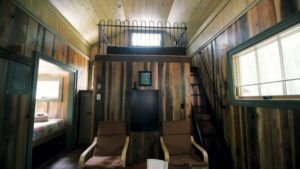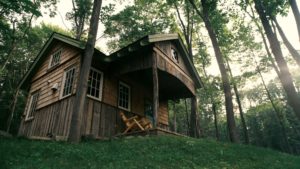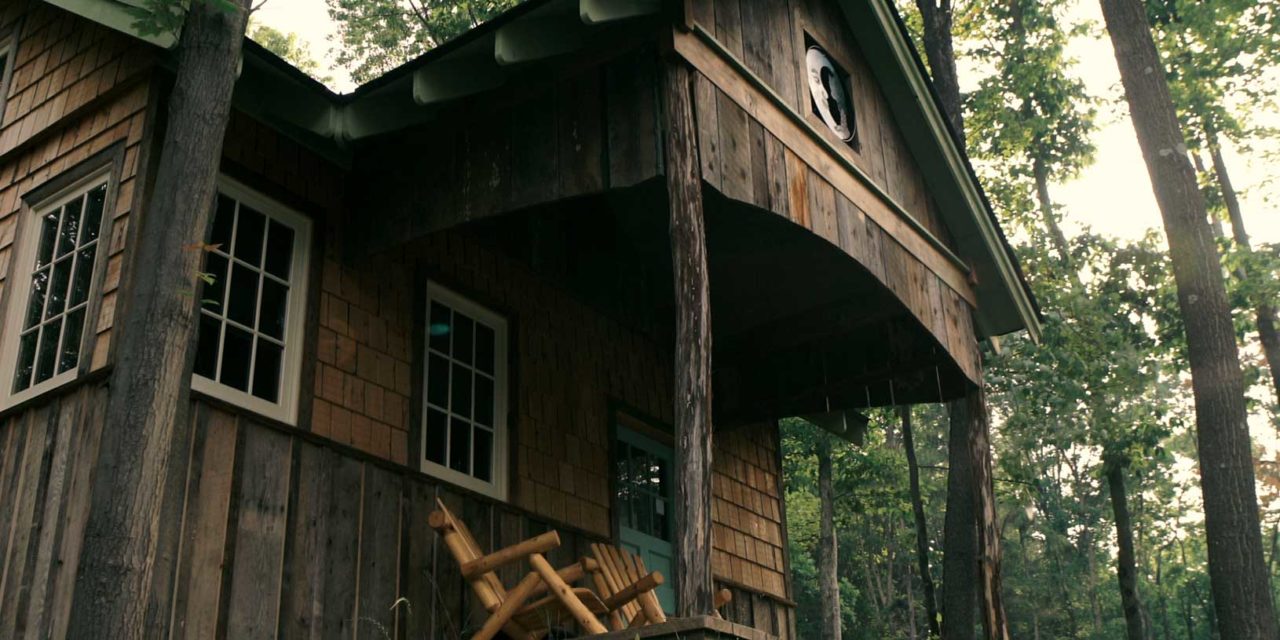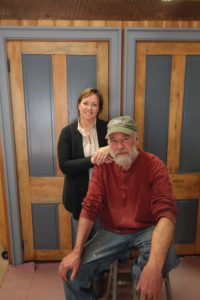by Jeffrey B. Roth
In a forest, on a mountain, by Deep Creek Lake, sit 13 homey hobs.
A hob is a tiny house built by Hobbitat, which is owned by former Carroll County residents, Bill and Sue Thomas, who now live in Garrett County. Bill Thomas is a building contractor, whose family roots are part of Westminster’s economic and entrepreneurial history. In 1981, about eight years after graduating from college, Bill and Sue started the contracting business, Blue Sky Ventures. The company specialized in historic restoration, remodeling and designing and building new homes.
“We lived in Carroll County on the Old Taneytown Road, until 1995, when we left to come here – Oakland, near Deep Creek Lake,” Bill said. “Hobbitat was started in January of 2012, after I had worked for 30 years in the historic restoration and custom home business.”
Blue Sky Ventures has been featured in Country Living, The Baltimore Sun, The Washington Post and he won an award from the Maryland Historic Trust for the complete restoration of an early 1700’s house called (Bare) Bear Garden, in Frederick County. The stone house was in utter disrepair and nearly falling down when Bill was hired to do the restoration, Sue said. The house was restored to its appearance in 1836.
“One of the projects in Carroll County, which ended up in Country Living was a renovation of an existing house and an addition of a log cabin,” said Sue, who met Bill, while working at Maggie’s Restaurant, where Bill was a bartender. “It looked like the log cabin was there first and the rest was added on.”
 At the time, the historic restoration work fired the couple’s passion for using reclaimed and re-purposed building materials. For various restoration projects, old barn timbers and other architectural features, such as old doors, etc., were located and incorporated into restored buildings, Bill said.
At the time, the historic restoration work fired the couple’s passion for using reclaimed and re-purposed building materials. For various restoration projects, old barn timbers and other architectural features, such as old doors, etc., were located and incorporated into restored buildings, Bill said.
Fast forward to January 2012, when Hobbitat was founded.
For the previous 15 years, the company thrived from designing custom-built homes, but Bill and Sue recognized a desire and a need for smaller homes, which optimized size and efficiency. They refocused their energy on building smaller homes and moved the construction operation inside, Sue said.
The name Hobbitat is a compound of the words hobbit and habitat, Sue said. The tiny houses, called hobs, have a total living space of about 250 to 600-square feet. Designed to be energy-efficient, the hobs incorporate new and re-purposed materials, such as salvaged old doors, Bill said. The Thomases have traveled to Buffalo, NY, Philadelphia, PA, and south to Charlottesville, VA to salvage old railroad ties, and doors from old neighborhood houses in Baltimore.
To build their first hob, the Thomases used wood salvaged from an old barn, located on Center Street, in Westminster, which had belonged to Bill’s grandfather, Frank W.B. Thomas, a well-known land developer, entrepreneur and bank owner.
 Frank W.B. Thomas once resided on the second floor of a building that also housed the bank he owned. The building was located where the old Westminster Post Office is now located; which, coincidentally, is the home of Kohn Creative, which publishes Carroll Magazine and Hanover Magazine, Sue said.
Frank W.B. Thomas once resided on the second floor of a building that also housed the bank he owned. The building was located where the old Westminster Post Office is now located; which, coincidentally, is the home of Kohn Creative, which publishes Carroll Magazine and Hanover Magazine, Sue said.
The barn, located on the last farm to exist within the city limits of Westminster, was demolished. City officials offered Bill the chance to salvage the structure. The barn yielded two tractor-trailer loads of salvaged wood. The salvaged wood was used to build the first hob, Sue said.
“I don’t even know how it all started,” Bill said, referring to Hobbitat. “I wasn’t even aware of the tiny house thing, but we decided that this would be a cool idea, and we decided to build them inside. We built the first one in our little shop back at the house and then set it up on our property.”
At the same time, Lisa M. Jan, owner of the Blue Moon Rising Center for Sustainable Education, an ecotourism venture at Deep Creek Lake, had heard of Bill and his reputation for building quality custom homes, Sue said. Jan recruited Bill to work on the Blue Moon Rising project. Those hobs are used as vacation getaways.
“Her original designs were big, kind of crazy-round things that they decided really could not be built,” Sue explained. “She came out and saw our original little building and she decided that would be the direction Blue Moon would go and we did 13 hobs for them.”
For the Tiny House Nation Halloween Special, the producers of Tiny House Nation, chose three of the top Halloween designers in the nation, who were each given a week to convert a tiny house into a tiny haunt, said Randy Jones, co-executive producer for the special produced by Loud TV. One of the tiny houses selected for the project was a hob at Blue Moon Rising.
“We chose Blue Moon rising because we were looking for a small community of tiny houses,” Jones said. “We loved the mountain landscape and felt the area was perfect for our Halloween designers to create something really special. At the end of the week, we invited the residents of the town to come see the Tiny Haunted Houses and choose a winner. We met Bill while we were filming and he shared his story and his process of how he reclaims and reuses found materials in his design. We would love to work with Bill and Hobbitat in the future.”
Jones said Bill and Sue’s hob designs are unique and special. The hobs, according to Jones, are one of a kind. The Blue Moon Rising hobs feature a three-quarter size kitchen, no oven, a small, under-counter refrigerator and no washer or dryer. Most of the beds are located in the loft or are Murphy beds that pull down or nooks with a bed that can only be accessed from one side.
At the time of the interview in early April, Bill and Sue were building the first, full-time hob residence for David and Katharine Law of Reston, Va. The 573-square foot residence, which includes a loft, is the largest hob built to date. The Laws are planning for their retirement and decided they wanted to downsize their living space.
“We have hob plans available on the website,” Bill said. “For Dave, we talked about what they wanted, and how they need to use this thing. Then we designed one for them. We don’t ever build the same hob twice. Their hob has a washer and dryer, a stove and oven, a refrigerator—all the stuff you need to live there full-time. It has closets in the bedroom and you can access the bed from both sides.”
The hobs are hoisted upon a specially designed trailer and transported to a location of the customer’s choice, Bill said. The hobs are slid off the trailer and placed on piers and adjusted. The roof comes in two sections. Small additions, which Bill calls “bump-outs,” are also installed with the hobs It takes a day to complete a typical set-up.
The price of Hobbitat hobs range in price from $100,000-$150,000, complete with appliances, beds, heating system, installation and set-up, Bill said. Tiny house owners tend to be either baby boomers or millennials—people in the process of first starting out or retiring. In the future, Bill hopes to build a hob community.
“We are really hoping we get a family group or friends, who buy a piece of property for a cluster of small hobs surrounding a larger communal building with a commercial kitchen for group dinners,” Bill said. “Each family would have their own hob away from the main building. I think it makes sense because people are looking for a sense of community.”
Bill and Sue recommend that potential buyers visit Blue Moon Rising to “test drive” one of the vacation rental hobs, before they decide to have a hob custom-built. For people who are considering living full-time in a hob, Sue said it’s extremely important that they can get along with their significant others in a small, shared space.
For more information:
Hobbitat, www.hobbitatspaces.com; Tiny House Nation, www.fyi.tv/shows.tiny-house-nation.com.



